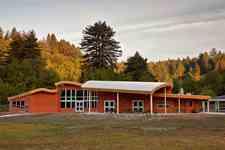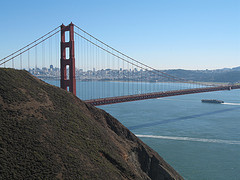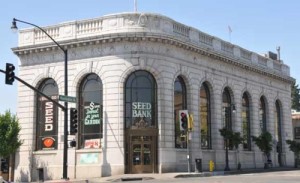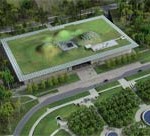 The recently certified Salmon Creek Falls Environmental Center is the first LEED Platinum certified K-12 public school in California, and it is also the first building in Sonoma County to achieve LEED Platinum certification. (The first commercial/non-residential building, that is. I believe that a private residence in Healdsburg was actually the first project to achieve LEED Platinum in Sonoma County.) To the best of my knowledge, the Salmon Creek Falls Environmental Center is the first Platinum rated non-residential building in the entire North Bay region of the Bay Area (Sonoma, Napa, and Marin counties). The Center is located on the site of the Harmony Union Schools (Harmony Elementary and Salmon Creek Middle School) in Occidental, CA, a town in the redwoods to the west of Santa Rosa. The building serves the school district as well as the surrounding community. It includes an auditorium, cafeteria and kitchen, and meeting rooms; and it has many green features, including a vegetated, flower-covered “living roof.”
The recently certified Salmon Creek Falls Environmental Center is the first LEED Platinum certified K-12 public school in California, and it is also the first building in Sonoma County to achieve LEED Platinum certification. (The first commercial/non-residential building, that is. I believe that a private residence in Healdsburg was actually the first project to achieve LEED Platinum in Sonoma County.) To the best of my knowledge, the Salmon Creek Falls Environmental Center is the first Platinum rated non-residential building in the entire North Bay region of the Bay Area (Sonoma, Napa, and Marin counties). The Center is located on the site of the Harmony Union Schools (Harmony Elementary and Salmon Creek Middle School) in Occidental, CA, a town in the redwoods to the west of Santa Rosa. The building serves the school district as well as the surrounding community. It includes an auditorium, cafeteria and kitchen, and meeting rooms; and it has many green features, including a vegetated, flower-covered “living roof.”
Here is my listing of all North Bay building projects that have achieved LEED certification to date. And here’s a longer listing of green building projects (of all sorts, not only LEED projects) that I’m aware of in the North Bay.
And a quick update on the stats for LEED Platinum projects worldwide: According to my latest calculations (as of December 2009), 46 states and 12 countries (including the U.S.) now have at least one LEED Platinum certified building. China and Great Britain are the latest countries to join the ranks of those with a LEED Platinum rated project. Within the United States, California—with more than 50 Platinum certified projects so far—is home to more Platinum projects than any other state.
December 17, 2009
 The following are key online resources for information on federal, state, and local environmental tax credits, rebates, and other financial incentives. Most of the incentives that are available are for installing energy-efficient equipment or renewable energy (e.g., solar) technologies.
The following are key online resources for information on federal, state, and local environmental tax credits, rebates, and other financial incentives. Most of the incentives that are available are for installing energy-efficient equipment or renewable energy (e.g., solar) technologies.
FEDERAL
This is a good directory of federal income tax credits and other incentives for energy-efficient products—for consumers, as well as businesses, builders, and manufacturers: Energy Tax Incentives Assistance Project
(For info on federal grants to organizations and agencies, go to Grants.gov.)
STATE AND LOCAL
Check out the Database of State Incentives for Renewables and Efficiency for a compendium of options, organized by state. Also check with your municipality (city and county governments) and local utility companies. Many offer their own green rebates and incentives. And this is a great summary of energy-efficiency grants and funds provided to state and local agencies by the 2009 economic stimulus/recovery bill (ARRA).
CALIFORNIA
For those of you who are in California, there are numerous entities offering green rebates and other incentives. Take a look at these resources:
If you know of other useful directories or resources related to green financial incentives, or if you have made use of energy tax credits or other green incentives, please share your experiences or suggestions by leaving a comment below.
November 16, 2009
If you’ll be in the San Francisco Bay Area during the first week of October, consider attending one or both of these entertaining and edifying events, which will be taking place in San Francisco and in West Marin County respectively:
West Coast Green, San Francisco
Expo + conference on green innovation for the built environment
Fort Mason Center
October 1-3, 2009 (Thursday – Saturday)
www.westcoastgreen.com
3rd Annual Point Reyes Green Homes Tour, Pt. Reyes Station
Organized by the Community Land Trust Association of West Marin (CLAM)
October 4, 2009 (Sunday)
www.clam-ptreyes.org
If you’d like to recommend other green events that will be happening in the Bay Area this fall, feel free to mention them in the Comments section.
September 7, 2009
This is an addendum to the previous post for those of you who live in (or near) Marin or Sonoma County, California.
 We are fortunate to have a plethora of amazing farms and sustainable agriculture resources in this area. One very cool new addition to our local scene is the “Seed Bank” store, located in a historic bank building at a major intersection in downtown Petaluma (Washington and Petaluma Blvd.). The store sells more than 1,200 varieties of non-GMO Baker Creek Heirloom Seeds.
We are fortunate to have a plethora of amazing farms and sustainable agriculture resources in this area. One very cool new addition to our local scene is the “Seed Bank” store, located in a historic bank building at a major intersection in downtown Petaluma (Washington and Petaluma Blvd.). The store sells more than 1,200 varieties of non-GMO Baker Creek Heirloom Seeds.
Our area is also home to many farmers markets, as well as wonderful organizations (and businesses) such as:
Marin Organic :: MALT (Marin Agricultural Land Trust) :: Grown in Marin :: Petaluma Bounty :: Sonoma County Farm Trails :: Occidental Arts and Ecology Center :: Ag Innovations Network :: Harmony Farm Supply & Nursery :: Mostly Natives Nursery :: Permaculture Skills Center [NEW: Added 2014] :: F.E.E.D. Sonoma Farmers Exchange [NEW]
You might also want to check out the Hidden Bounty of Marin, a recently produced 1/2-hour film about the farms and farmers of beautiful West Marin; it shows the rich variety of agricultural enterprises in this region—from dairy, produce, and oyster farming to cattle, hog, and sheep ranching.
There are many great family farms in this area. Wild Blue Farm, Toluma Farms (goat dairy), and Straus Family Creamery are some of my favorites, as they’re the farms that I’m most familiar with.
And lastly, here’s my list of links to other sustainability-related resources in the North Bay region of the San Francisco Bay Area. If you have other favorite local organizations or resources to recommend, please share them in the Comments section below. Thanks!
August 6, 2009
 The new California Academy of Sciences museum in San Francisco’s Golden Gate Park recently opened its doors to the public. The building achieved the Platinum (top-tier) rating in the LEED (Leadership in Energy and Environmental Design) green building rating system. Designed by Renzo Piano, Stantec Architecture, and Arup, the 410,000-square-foot building is the largest public Platinum-rated project in the world (to date). Featuring a four-story rainforest exhibit, an aquarium, a planetarium, and an enormous (and hilly) “living roof” (AKA a vegetated or green roof) that visitors can access, the museum is proving to be wildly popular. If you go there soon, be prepared for crowds.
The new California Academy of Sciences museum in San Francisco’s Golden Gate Park recently opened its doors to the public. The building achieved the Platinum (top-tier) rating in the LEED (Leadership in Energy and Environmental Design) green building rating system. Designed by Renzo Piano, Stantec Architecture, and Arup, the 410,000-square-foot building is the largest public Platinum-rated project in the world (to date). Featuring a four-story rainforest exhibit, an aquarium, a planetarium, and an enormous (and hilly) “living roof” (AKA a vegetated or green roof) that visitors can access, the museum is proving to be wildly popular. If you go there soon, be prepared for crowds.
For details about the building’s sustainable design features, go to:
www.calacademy.org/academy/building/sustainable_design
If you’d like to know where other LEED Platinum buildings are throughout the country or the world, click here: LEED Platinum Certified Buildings Worldwide. I also developed an interactive Google map of green buildings in San Francisco, and I keep updated lists of green building projects in the San Francisco Bay Area and all LEED certified projects in Northern California.
February 7, 2009
 The recently certified Salmon Creek Falls Environmental Center is the first LEED Platinum certified K-12 public school in California, and it is also the first building in Sonoma County to achieve LEED Platinum certification. (The first commercial/non-residential building, that is. I believe that a private residence in Healdsburg was actually the first project to achieve LEED Platinum in Sonoma County.) To the best of my knowledge, the Salmon Creek Falls Environmental Center is the first Platinum rated non-residential building in the entire North Bay region of the Bay Area (Sonoma, Napa, and Marin counties). The Center is located on the site of the Harmony Union Schools (Harmony Elementary and Salmon Creek Middle School) in Occidental, CA, a town in the redwoods to the west of Santa Rosa. The building serves the school district as well as the surrounding community. It includes an auditorium, cafeteria and kitchen, and meeting rooms; and it has many green features, including a vegetated, flower-covered “living roof.”
The recently certified Salmon Creek Falls Environmental Center is the first LEED Platinum certified K-12 public school in California, and it is also the first building in Sonoma County to achieve LEED Platinum certification. (The first commercial/non-residential building, that is. I believe that a private residence in Healdsburg was actually the first project to achieve LEED Platinum in Sonoma County.) To the best of my knowledge, the Salmon Creek Falls Environmental Center is the first Platinum rated non-residential building in the entire North Bay region of the Bay Area (Sonoma, Napa, and Marin counties). The Center is located on the site of the Harmony Union Schools (Harmony Elementary and Salmon Creek Middle School) in Occidental, CA, a town in the redwoods to the west of Santa Rosa. The building serves the school district as well as the surrounding community. It includes an auditorium, cafeteria and kitchen, and meeting rooms; and it has many green features, including a vegetated, flower-covered “living roof.”
 The following are key online resources for information on federal, state, and local environmental tax credits, rebates, and other financial incentives. Most of the incentives that are available are for installing energy-efficient equipment or renewable energy (e.g., solar) technologies.
The following are key online resources for information on federal, state, and local environmental tax credits, rebates, and other financial incentives. Most of the incentives that are available are for installing energy-efficient equipment or renewable energy (e.g., solar) technologies.

